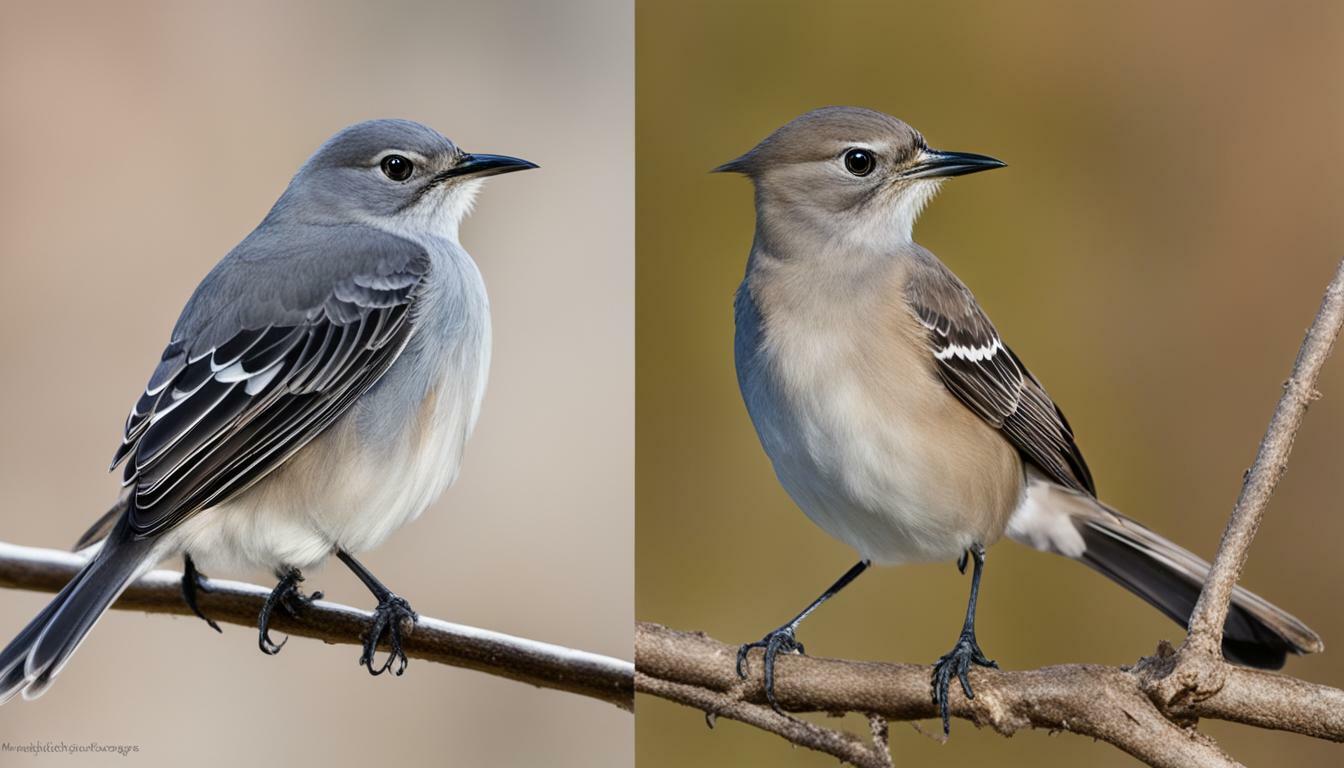If you’re a bird lover, you might have come across the Northern and Southern Mockingbirds. While these two species might seem similar at first glance, there are several distinct differences between them. In this article, we’ll explore the characteristics, habitat, and behavior of both Northern and Southern Mockingbirds to help you spot the difference.
Key Takeaways:
- There are differences between Northern and Southern Mockingbirds.
- Each species has unique characteristics, habitat, and behavior.
- Knowing the differences can help you identify which species you’re observing.
Characteristics of Northern Mockingbirds
The Northern Mockingbird, scientifically known as Mimus polyglottos, is a medium-sized bird with distinctive markings. These birds have grayish-brown backs and wings with white undersides. They have a long tail with white feather tips and a wingspan of about 14 inches. The Northern Mockingbird is known for its singing prowess, with a repertoire of over 200 songs and calls.
One of the most noticeable characteristics of the Northern Mockingbird is its ability to mimic sounds it hears in its environment. They not only imitate other birds’ songs but also sounds from machinery and even car alarms. The Northern Mockingbird is also known for its territorial behavior, which it displays by singing loudly and chasing off other birds and animals from its territory.
The bill of the Northern Mockingbird is slender and slightly curved, which helps it catch its prey, consisting mainly of insects, earthworms, and small fruits. These birds are also known for their sharp eyesight and agility, which helps them spot and capture their prey with ease.
Characteristics of Northern Mockingbirds:
| Physical Characteristics | Behavioral Characteristics |
|---|---|
| Grayish-brown backs and wings with white undersides | Territorial behavior |
| Long tail with white feather tips | Mimics sounds in the environment |
| Slender, slightly curved bill | Singing prowess with a repertoire of over 200 songs and calls |
Overall, the Northern Mockingbird is a unique bird with several distinctive characteristics that set it apart from other birds. Its singing ability and territorial behavior make it a fascinating bird to observe in the wild.
Characteristics of Southern Mockingbirds
Southern Mockingbirds, also known as Gray Mockingbirds, are native to the southeastern United States, Mexico, and Central America. They are slightly smaller than Northern Mockingbirds, weighing between 1.3 to 1.8 ounces with a wingspan of 9 to 11 inches.
One of the most distinctive features of Southern Mockingbirds is their gray coloration. They also have a white patch on their wings and a long tail with white outer feathers. Their beaks are slightly curved and longer than a Northern Mockingbird’s beak.
Southern Mockingbirds are known for their beautiful and complex songs, which are often repeated in a sequence. They use their songs to establish their territory and attract mates. In addition, Southern Mockingbirds have a unique behavior of “wing flashing,” where they rapidly open and close their wings while singing.
These birds are also known for their aggressive behavior, especially during breeding season. They fiercely defend their territory and nests from predators and other birds.
Unlike Northern Mockingbirds, Southern Mockingbirds prefer wooded areas, including forests, scrublands, and gardens. They are primarily active during the day, but may occasionally sing at night.
In summary, Southern Mockingbirds stand out with their gray coloration, long beaks, and beautiful songs. They exhibit unique behaviors such as “wing flashing” and are known for their territorial protection. Their preferred habitat includes wooded areas, making them slightly different from their Northern counterparts.
Habitat of Northern Mockingbirds
As the name suggests, Northern Mockingbirds are primarily found in the Northern regions of America, including parts of Canada, the United States, and Mexico. These birds prefer open habitats such as suburban areas, farmland, parks, and gardens.
They are known for their adaptability to urban environments and can often be spotted in city parks or residential areas with ample greenery and bushes to nest in.
During the breeding season, Northern Mockingbirds favor nesting in thorny bushes or small trees, using them for protection against predators.
| Habitat | Features |
|---|---|
| Open habitats | Suburban areas, farmland, parks and gardens |
| Nesting | Thorny bushes or small trees |
Overall, Northern Mockingbirds are adaptable birds that can thrive in a variety of environments as long as they have access to open areas to forage and nest.
Habitat of Southern Mockingbirds
Southern Mockingbirds are found primarily in the southeastern regions of the United States, as well as in parts of Central America and the Caribbean. They prefer warmer climates, specifically coastal areas, and are known to live in a variety of habitats including forests, gardens, and open fields.
Unlike Northern Mockingbirds, Southern Mockingbirds are not known to inhabit urban areas. They prefer to nest in shrubs or low trees, and can often be found perched on fence posts or telephone wires.
Southern Mockingbirds are also known to be territorial and will defend their chosen nesting areas aggressively. They are adaptable birds and can adjust to changes in their habitat, but prefer areas with plenty of cover such as brush piles, shrubs, and trees.
Overall, the Southern Mockingbird’s preferred habitat is quite similar to that of the Northern Mockingbird. However, their range is more limited, and they tend to avoid urban areas.
Behavior of Northern Mockingbirds
Northern Mockingbirds are known for their bold and confident behavior. These birds are extremely territorial and will aggressively defend their nests and feeding areas from other birds or even larger animals.
They are also known for their incredible singing abilities, mimicking the sounds of other birds and even some non-avian species. Northern Mockingbirds use their songs to establish their territory and attract mates.
During the breeding season, males will often perform elaborate flight displays, rising high into the air and then descending rapidly while singing. This behavior is believed to be part of their courtship ritual.
Aggressive Behavior
When threatened, Northern Mockingbirds are not afraid to stand their ground. They will puff up their chest, spread their wings, and engage in a staring contest with their opponent. If the threat persists, they may attack with their sharp beak and claws.
Despite their aggressive behavior towards other birds, Northern Mockingbirds are known to form strong pair bonds with their mates. They will aggressively defend their nests and young, even attacking much larger animals to protect their offspring.
Feeding Behavior
Northern Mockingbirds are primarily insectivorous, feeding on a wide variety of insects and invertebrates. They will also eat fruits and berries when available.
These birds are known for their acrobatic feeding behavior, often hovering in mid-air to catch flying insects or leaping into the air to snatch insects from leaves or branches.
Courtship Behavior
During the breeding season, Northern Mockingbirds engage in elaborate courtship displays. Males will perch near potential females and sing complex songs, often incorporating the calls of other bird species into their repertoire.
Male Northern Mockingbirds may also fly high into the air and then descend rapidly while singing, a behavior known as the “moth-flight display.” This behavior is believed to be a way to attract mates and establish territory.
Behavior of Southern Mockingbirds
Southern Mockingbirds are known for their feisty behavior and assertive personalities. They are territorial birds and will defend their space vigorously against any perceived threat, including other birds, animals, and even humans.
One of the most notable behaviors of Southern Mockingbirds is their ability to mimic the sounds of other birds and animals. They are known for their intricate vocalizations and can imitate up to 35 different species of birds.
Southern Mockingbirds are also known to be aggressive when it comes to feeding. They will fiercely defend their food sources, including fruit trees and bird feeders, and will chase away any other birds that try to get close.
Protective Parenting
During the breeding season, Southern Mockingbirds become very protective of their nests and young. They will aggressively defend their nesting territory, which can extend up to 10 acres, against any potential threats.
If a predator approaches their nest, such as a snake or a squirrel, Southern Mockingbirds will often dive-bomb the intruder in an attempt to deter them. They will also emit a series of loud alarm calls to alert other birds and animals in the area of the potential danger.
Overall, Southern Mockingbirds are fascinating birds with unique behaviors and characteristics that set them apart from their Northern counterparts.
Conclusion
In summary, the Northern and Southern Mockingbirds may look very similar at first glance, but there are actually quite a few differences between the two. The Northern Mockingbird is slightly larger, with a longer tail and a more varied song repertoire. On the other hand, the Southern Mockingbird has a slightly shorter beak and a more streamlined body shape.
When it comes to habitat, the Northern Mockingbird prefers open areas with short grass, while the Southern Mockingbird prefers denser vegetation and wooded areas. In terms of behavior, the Northern Mockingbird is known to be more aggressive and territorial, while the Southern Mockingbird is more social and cooperative.
Overall, the main difference between these two species of Mockingbirds lies in their physical characteristics, preferred habitats, and behavioral tendencies. Whether you’re a bird enthusiast or simply enjoy observing nature, taking the time to spot the differences between Northern and Southern Mockingbirds can be a rewarding experience. So get out there and see if you can spot the difference!
 Skip to main content
Skip to main content


